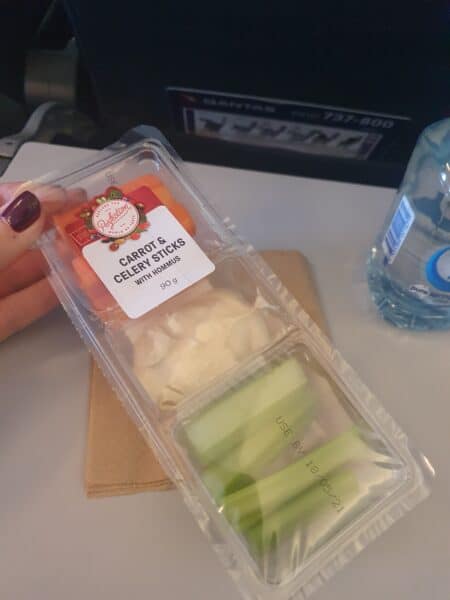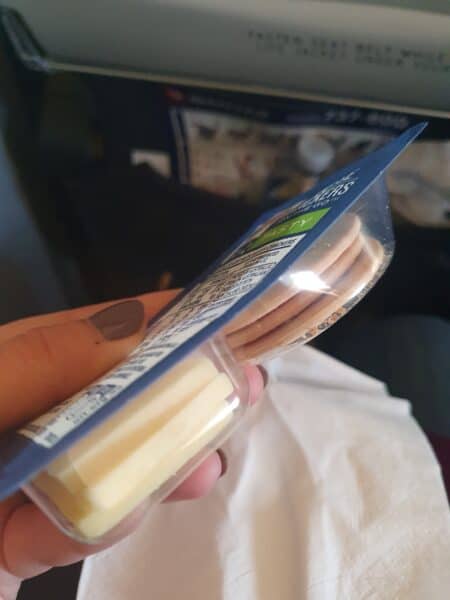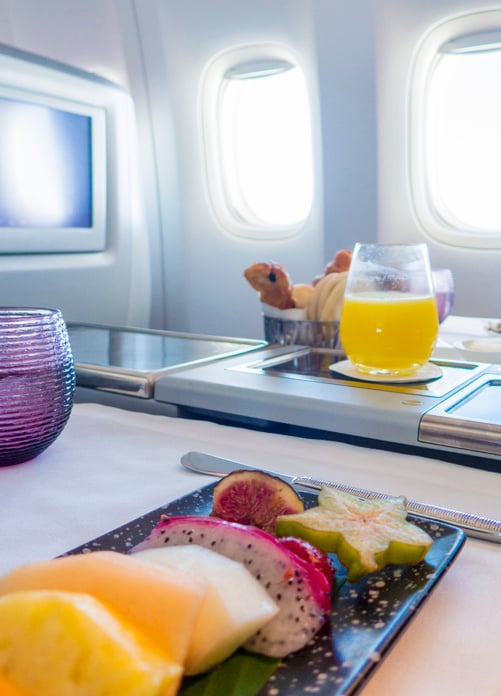Did you even fly if you didn’t have a snack on a plane? A bag of complimentary nuts on a plane is associated with flying, and many airlines have branched out over the years offering more elaborate snacks to customers across different fare classes. And with all the choice these days, both on board and in airport lounges, it can be hard to navigate the snacking landscape – especially if there aren’t other meal options served.
Why you need to think about that snack
While snacks may seem small and inconsequential to many people (like they are only a couple of mouthfuls – right?), they add up when eaten regularly and impact your health. Snacks provided by airlines on planes and in lounges, and in airport food courts and vending machines, are usually ultra processed convenience foods with long shelf lives – think packets of crisps (chips), chocolates, lollies, cakes, cookies, rice crackers, packaged sandwiches etc. These foods are usually high in energy (calories/kilojoules), with added sugars, fats, salt, and preservatives, and are made from highly processed ingredients such as modified starches, proteins etc.
Even if a snack looks like it is a small portion (and has a small number of calories), it still doesn’t necessarily mean it is a good choice due to the ultra processed nature of many snacks. The ingredients may mean some snacks are low in nutrient quality, meaning it isn’t really nutritious. And for some highly processed snacks, it can mean it is quickly digested by the body causing fast spikes in blood sugar levels which overtime can have negative impacts on health. Here are some examples of processed snacks served in lounges:





What does this mean for snacks on flights?
Overall it is a combination of the energy, nutrients, and ingredients that determine whether a snack is a good choice to have.
For example take the snacks below which were all served on 1 hour domestic flights in Australia. While cookies (biscuits) or cakes can be a nice snack to have occasionally, it is important to understand just how much energy a cookie can contain. The two cookies below have approximately 1000kj/ cookie. To put this is perspective this is nearly as much energy as a McDonalds Cheeseburger (~1200kj), the equivalent energy to a full size Mars Bar (1020kj), and more than 2 slices of wholemeal bread (810kj).
So if you have just had breakfast or a snack in the lounge before your flight, you can start to see how it can be easy for your energy intake to quickly add up if you then chose to have a snack on the plane, especially without being hungry.
So even if you do not fly often, you can start to see why it is important to still pay attention to your snacks.



What I look for in a snack when travelling
So what does this all mean and what I (as a travel dietitian and nutritionist, and frequent flyer) do when considering whether to eat a snack while flying? There are a number of factors I consider when deciding if a snack is a good choice while I am travelling:
- The types of carbohydrates and are these quite refined?
- The amount of fibre and protein.
- The sodium (or salt) levels.
- If it is an ultra-processed food or the amount of processing.
- The ratio of unsaturated fats to saturated/trans fats.
- The ingredient list and the types of ingredients.
- The energy content.
- How filling the snack is likely to be.
- The overall flight menu and how the snack fits in with the flight time.
- Antioxidants, phytonutrients, vitamins and minerals
- When I last ate and what I had.
Types of snacks to aim for when travelling
- Cheese and wholegrain crackers
- Whole fruit or fruit salad
- Nuts and seeds (only where appropriate – it is important to understand whether there is anyone on board with an allergy)
- No/low added sugar yogurt
- Vegetables with dips
- Half a sandwich with predominantly salad and protein filling
- Roasted chickpeas (or other types of legumes)
- Cookies/cakes/slices with sugar not in the first 2 or 3 ingredients






A final tip for choosing snacks
While I have talked about the nutrition aspect of choosing snacks, it is also important to take into consideration our appetites and hunger levels. It can be easy to eat when we are not hungry when foods are offered for free when flying. Even if a snack is technically considered ‘healthy’, it is important to listen to our hunger cues and not eat just because foods are offered to us. So next time a snack is offered to you when flying, take a moment to think about how hungry you are, when you last ate and when you are likely to eat next. I take a moment to do this when offered snacks while flying and it helps me decide whether to take the snacks on offer.
And one last important consideration – do you actually like the snack? All too often I talk with clients about snacks and I ask did they even like it? A lot of the time the answer is no. And when I ask why they ate it, often the response is because it was offered to me. So take a moment to consider if you even like what is being served, and if you do is the quality any good. For me, I LOVE chocolate. And when served something like a chocolate cake or brownie I always have a look/taste to see if it is any good. If it isn’t I don’t eat it. I just consider it a waste if I eat something like that and don’t like it. I would rather savor a really great quality chocolate brownie and enjoy it than eat one and go ugh that was awful and unsatisfying.
So overall navigating snacks can be tricky when flying, but by taking into consideration the nutrition, your hunger levels and personal tastes, you are on a good path to balancing the enjoyable aspects of flying with helping to improve your health.
NOTE: All pictures are my own and for this article there are many Qantas examples. This is mainly because for the last 2 years during and just after Covid I have predominantly flown Qantas domestic due to International border closures in Australia. I will have examples from other airlines as my travel continues to grow now the Covid situation is changing and I get back to more regular flying like pre covid times.
For more travel nutrition information don’t forget to follow me on Instagram and Tik Tok. And I always love hearing from you so please reach out to me at any time.



